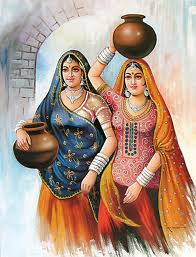 Indian
Paintings often depict a complete world, a world constructed rather than
depicted realistically and sometimes a completely imaginary one. Divided
thematically into religious, romantic, musical, and courtly subjects, the
paintings provide glimpses into some of the many worlds painted by Rajput and
Mughal artists in the sixteenth to nineteenth centuries. Many delighted in
verdant nature, in a courtyard garden, or in a lush forest after the monsoon. The
sixth-one paintings reveal various scenes as they appeared before the mind’s eye
of the artist: a shy Radha approaching Krishna; a lover tearing through the
woods to a tryst in the night; a ragini dancing in the forest amid musical
accompanies; a price on a tiger hunt.
Indian
Paintings often depict a complete world, a world constructed rather than
depicted realistically and sometimes a completely imaginary one. Divided
thematically into religious, romantic, musical, and courtly subjects, the
paintings provide glimpses into some of the many worlds painted by Rajput and
Mughal artists in the sixteenth to nineteenth centuries. Many delighted in
verdant nature, in a courtyard garden, or in a lush forest after the monsoon. The
sixth-one paintings reveal various scenes as they appeared before the mind’s eye
of the artist: a shy Radha approaching Krishna; a lover tearing through the
woods to a tryst in the night; a ragini dancing in the forest amid musical
accompanies; a price on a tiger hunt.
The
Indian paintings (often wrongly characterized as miniatures) discussed were
created mostly by unknown artists between about 1550 and about 185o. The
patrons of these works of art also are by and large unknown as individuals. In
general, however, they were members of ruling families and courtiers, of both
sexes, Hindus as well as Muslims. In fact, the role of women patrons in Indian
painting is yet to be properly assessed. Over three decades ago William Archer,
noting the power of Indian painting to charm both sexes, guardedly stated that
while Indian women also viewed it, it owed “its origins to masculine stimulus”.
Although the evidence is not abundant, there is little doubt that women too
patronized the various arts, including painting. A well-known instance is
Princess Jahanara, the eldest daughter of the Mughal Emperor Shah Jahan.
The
paintings in the Green collection consist mostly of book illustrations and
folios from albums. Small in scale, like European watercolors or Japanese
prints, they are easily portable. Therefore, a series or picture found in one
court may have been made somewhere else. They were never hung up on walls, but
held in hand and viewed intimately. In fact, the patron usually held a painting
at the same oblique angle when viewing as the artist did when painting it. When
not being looked at, the pictures were bundled up and stored in libraries or
special storerooms in the palace or mansion. They were, therefore, well
shielded from light, which is one reason why some of the pictures, although
three or more centuries old, are remarkably well preserved. (In some cases
where the storage conditions were less than ideal, the pictures were adversely
affected.)
The
small scale of the pictures does not mean that they are not technically
complex. The support of all the pictures is paper, and the pigments are water
based, though they are more opaque than English watercolors. Indian artists
also enriched their palette with gold,and urn ii the middle of the nineteenth
century, when European commercial paints were introduced, most pigments were
derived from plants and minerals with the exception of a pungent yellow called
peon, which was extracted from the urine of cows fed mangos. In their rich
detailing Indian pictures more often approximate the art of the European
miniature rather than that of the watercolor.
Many
of the pictures have inscriptions, which may or may not be relevant. There is
no rule governing the placement of textual material: inscriptions can occur on
the front and/or the back of a painting. In some cases the text is simply a
label identifying the subject, added either on the front or the back; in
others, it may be a verse or verses, often from a work of literature, briefly
describing the theme or recounting the story of the picture. Whereas some
pictures relate to their text closely, others seem to deviate significantly.
Occasionally an inscription provides us with relevant art-historical
information, such as the identity of the sitter or the name of an artist or a
date. In albums specially prepared for Muslim patrons, panels of poetry are
often pasted around a picture, but rarely are they related.
It
is customary to divide these paintings into two broad categories: Mughal and Raj
put. The expression Mughal (or Mogul) is the designation of the Muslim dynasty
founded by Babur, a Central Asian Turkic invader, in 1526. His grandson Akbar expanded
his inheritance to build an enormous pan-Indian empire that included parts of
Afghanistan in the northwest and extended south into the Deccan plateau. All
the important Decanis Muslim kingdoms, however, were not absorbed into the
Mughal Empire until the 168os, during die rule of Aurangzeb (1658-1707). the
last great Mughal emperor. After Aurangzeb, Mughal authority declined steadily
until the British united much of the subcontinent under their crown in 1858.
Pictures and books prepared for the emperors, their Muslim courtiers, and later
for independent Muslim rulers in north India are generally categorized as
Mughal. Mughal paintings have been further subdivided by art historians into
imperial, sub imperial, provincial, popular, and later Mughal. A parallel
tradition of painting flourished in the Islamic courts of the Deccan and is
usually categorized as Deccan.
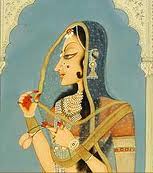 During
the Mughal period, much of present-day Madhya Pradesh, Gujarat, and Rajasthan
was peppered with semi-independent Hindu states of different sizes and power. The
rulers of these states, who belonged to various clans, are known collectively
as Rajput, derived from the word rajaputra, meaning "prince". In
the early decades of this century the noted art historian Amanda K.
Coomaraswamy used the term Rajput to describe paintings that were done for the
Raj put patrons. Pictures were also painted for the Hindu courts in that
section of the western Himalayas that stretches across several states today
(Pakistani and Indian Punjab, Jammu and Kashmir, Himachal Pradesh, and Uttar
Pradesh). These pictures from the hills are generally referred to as Pahari,
the Adjectival form of the word pahad, meaning "hill".
During
the Mughal period, much of present-day Madhya Pradesh, Gujarat, and Rajasthan
was peppered with semi-independent Hindu states of different sizes and power. The
rulers of these states, who belonged to various clans, are known collectively
as Rajput, derived from the word rajaputra, meaning "prince". In
the early decades of this century the noted art historian Amanda K.
Coomaraswamy used the term Rajput to describe paintings that were done for the
Raj put patrons. Pictures were also painted for the Hindu courts in that
section of the western Himalayas that stretches across several states today
(Pakistani and Indian Punjab, Jammu and Kashmir, Himachal Pradesh, and Uttar
Pradesh). These pictures from the hills are generally referred to as Pahari,
the Adjectival form of the word pahad, meaning "hill".
Under
the inspired patronage of the emperor Akbar the Mughal painting work-shop
achieved a brilliant synthesis of Persian, Indian, and European traditions. The
early Mughal workshop, which became an active center for book production,
employed a large number of native artists who worked under the direction of
masters brought from Iran. In addition to the fact that the Mughals' taste was
Persian, most of the books copied and illustrated were also Persian. The
Mughals preferred books of fables and cosmological subjects, epics and
romances, historical sagas and chronicles, and, of course, poetry. Like most
cultured Muslims, the Mughals also admired calligraphy, and examples of fine
penmanship were collected and assembled in albums. Moreover, the albums
included portraits of both humans and animals as well as flower studies At
first heavily influenced by Persian aesthetics, by the 158os Mughal artists
were exposed to European paintings and prints. The presence of European
miniature portraits and Akbar's own requirements to become familiar with his
courtiers contributed to the development of realistic portraiture in Mughal painting.
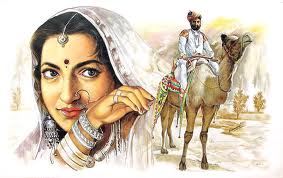
The
type of pictures that the Mughals encountered in India is best exemplified in
the Green collection by two illustrations from a Bhagavatapurana, a Hindu
religious text. This style, characterized by a limited palette, simple
compositions, and stylized figures, continued to be favored by Hindu patrons
well into the first quarter of the seventeenth century, after which, at some of
the Raj put centers, the artists became more aware of the "dramatic,
objective, and eclectic" as well as more painterly Mughal style. The
degree to which they absorbed Mughal stylistic elements differed at different
centers, depending upon the taste of the patron as well as the artists' own
aesthetic preferences and training. In some schools, such as at Malwa, the
influence was not strongly felt until the end of the seventeenth century, while
in the Hill States it was manifested later still. Notwithstanding the
interaction with Mughal painting, it is easy to recognize in Raj put pictures,
as Coomaraswamy pointed out long ago, "a great variety of motifs, compositions,
and formulae that occur commonly in much older Indian works or correspond to
the phraseology of classical rhetoric.
Mughal influence was not simply one of style
but also of subject. Until the seventeenth century both Hindu and Jain patrons
showed a marked preference for religious books, although some secular works
from the period have also survived. Inspired by Mughal tastes, Raj put
paintings began to depict court scenes, festivals, and other subjects of
worldly nature. Secular themes portrayed in Raj put pictures, however, are more
symbolic and idealized and are not as graphic and realistic as they are in
Mughal pictures. Moreover, Rajput depictions of romantic, rhetorical, or
musical themes were often given a strongly religious color. The archetypal
heroes and heroines (nayakas and nayikas), even if described in mortal
contexts, were frequently identified with the divine figures of Krishna and
Radha. In the pictures from some states, such as Kota and Kishangarh , the
rulers themselves were identified with Krishna.
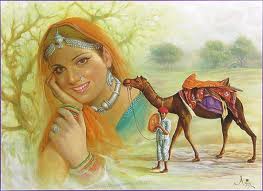
The development of painting in the many Rajput
courts is a complex issue and still subject to debate. Although attempts have
been made recently to distinguish styles of Pahari painting by families of
artists,' by and large Raj put paintings are still classified simply by the
semi-independent princely states that were merged into either India or Pakistan
when the British left the subcontinent in 1947. Thus, in the catalogue entries
names such as Basohli, Bikaner, Jodhpur, or Kangra denote the states where the
picture may have originated. Names of artists occur more commonly on Mughal
than Raj put works. Although families of artists may have been attached to a
court, there is strong evidence of the migration of artists from one state to
another in the hills. Moreover, as at least one artist in Rajasthan is known to
have moved from one court to another, it is very likely that others did too.
Painters also accompanied their patrons on duties away from their home courts,
such as military campaigns. It should further be noted that art moved about
freely from one state to another, especially in the form of presents or as part
of bridal trousseaus.
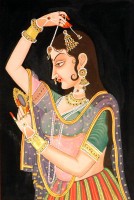 Since a large number of Rajput paintings has
emerged from royal collections, it would not be unjustified to assume that
rulers and their families were the major patrons. However, other courtiers as
well as educated and affluent merchants must have been interested in the arts,
and some works may have been made available in the bazaars for general
consumption. Although some artists enjoyed special relationships with their
patrons and may even have held elevated positions at court, generally the
professional artist did not have a higher status than a cook, a carpenter, or a
gardener. As a matter of fact, in a Hindu household the cook had a much higher
social position if he was a Brahman. Artists generally belonged to lower
castes. At the Mughal court Iranian and Muslim artists enjoyed a greater
status, partly because of their religious and cultural kinship with the rulers
and partly because Islamic society has never been as socially stratified as
that of the Hindus. However, there are instances of some Hindu artists
attaining exalted positions at court and enjoying a more familiar relationship
with their patrons.
Since a large number of Rajput paintings has
emerged from royal collections, it would not be unjustified to assume that
rulers and their families were the major patrons. However, other courtiers as
well as educated and affluent merchants must have been interested in the arts,
and some works may have been made available in the bazaars for general
consumption. Although some artists enjoyed special relationships with their
patrons and may even have held elevated positions at court, generally the
professional artist did not have a higher status than a cook, a carpenter, or a
gardener. As a matter of fact, in a Hindu household the cook had a much higher
social position if he was a Brahman. Artists generally belonged to lower
castes. At the Mughal court Iranian and Muslim artists enjoyed a greater
status, partly because of their religious and cultural kinship with the rulers
and partly because Islamic society has never been as socially stratified as
that of the Hindus. However, there are instances of some Hindu artists
attaining exalted positions at court and enjoying a more familiar relationship
with their patrons.
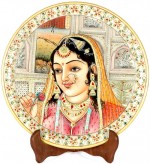 Whether
Mughal or Rajput, Indian pictures are fascinating for the variety and zest of
life they express. Whether they depict the material world or the mythic realm,
they attest to the limitless universe of the human imagination, and through
brilliant colors and forms they capture the spirit of the themes with admirable
candor. Displaying great delicacy, finesse, and lyrical charm, these small but
elegant pictures remain vivid evocations of a romantic past.
Whether
Mughal or Rajput, Indian pictures are fascinating for the variety and zest of
life they express. Whether they depict the material world or the mythic realm,
they attest to the limitless universe of the human imagination, and through
brilliant colors and forms they capture the spirit of the themes with admirable
candor. Displaying great delicacy, finesse, and lyrical charm, these small but
elegant pictures remain vivid evocations of a romantic past.
 Indian
Paintings often depict a complete world, a world constructed rather than
depicted realistically and sometimes a completely imaginary one. Divided
thematically into religious, romantic, musical, and courtly subjects, the
paintings provide glimpses into some of the many worlds painted by Rajput and
Mughal artists in the sixteenth to nineteenth centuries. Many delighted in
verdant nature, in a courtyard garden, or in a lush forest after the monsoon. The
sixth-one paintings reveal various scenes as they appeared before the mind’s eye
of the artist: a shy Radha approaching Krishna; a lover tearing through the
woods to a tryst in the night; a ragini dancing in the forest amid musical
accompanies; a price on a tiger hunt.
Indian
Paintings often depict a complete world, a world constructed rather than
depicted realistically and sometimes a completely imaginary one. Divided
thematically into religious, romantic, musical, and courtly subjects, the
paintings provide glimpses into some of the many worlds painted by Rajput and
Mughal artists in the sixteenth to nineteenth centuries. Many delighted in
verdant nature, in a courtyard garden, or in a lush forest after the monsoon. The
sixth-one paintings reveal various scenes as they appeared before the mind’s eye
of the artist: a shy Radha approaching Krishna; a lover tearing through the
woods to a tryst in the night; a ragini dancing in the forest amid musical
accompanies; a price on a tiger hunt.  During
the Mughal period, much of present-day Madhya Pradesh, Gujarat, and Rajasthan
was peppered with semi-independent Hindu states of different sizes and power. The
rulers of these states, who belonged to various clans, are known collectively
as Rajput, derived from the word rajaputra, meaning "prince". In
the early decades of this century the noted art historian Amanda K.
Coomaraswamy used the term Rajput to describe paintings that were done for the
Raj put patrons. Pictures were also painted for the Hindu courts in that
section of the western Himalayas that stretches across several states today
(Pakistani and Indian Punjab, Jammu and Kashmir, Himachal Pradesh, and Uttar
Pradesh). These pictures from the hills are generally referred to as Pahari,
the Adjectival form of the word pahad, meaning "hill".
During
the Mughal period, much of present-day Madhya Pradesh, Gujarat, and Rajasthan
was peppered with semi-independent Hindu states of different sizes and power. The
rulers of these states, who belonged to various clans, are known collectively
as Rajput, derived from the word rajaputra, meaning "prince". In
the early decades of this century the noted art historian Amanda K.
Coomaraswamy used the term Rajput to describe paintings that were done for the
Raj put patrons. Pictures were also painted for the Hindu courts in that
section of the western Himalayas that stretches across several states today
(Pakistani and Indian Punjab, Jammu and Kashmir, Himachal Pradesh, and Uttar
Pradesh). These pictures from the hills are generally referred to as Pahari,
the Adjectival form of the word pahad, meaning "hill". Since a large number of Rajput paintings has
emerged from royal collections, it would not be unjustified to assume that
rulers and their families were the major patrons. However, other courtiers as
well as educated and affluent merchants must have been interested in the arts,
and some works may have been made available in the bazaars for general
consumption. Although some artists enjoyed special relationships with their
patrons and may even have held elevated positions at court, generally the
professional artist did not have a higher status than a cook, a carpenter, or a
gardener. As a matter of fact, in a Hindu household the cook had a much higher
social position if he was a Brahman. Artists generally belonged to lower
castes. At the Mughal court Iranian and Muslim artists enjoyed a greater
status, partly because of their religious and cultural kinship with the rulers
and partly because Islamic society has never been as socially stratified as
that of the Hindus. However, there are instances of some Hindu artists
attaining exalted positions at court and enjoying a more familiar relationship
with their patrons.
Since a large number of Rajput paintings has
emerged from royal collections, it would not be unjustified to assume that
rulers and their families were the major patrons. However, other courtiers as
well as educated and affluent merchants must have been interested in the arts,
and some works may have been made available in the bazaars for general
consumption. Although some artists enjoyed special relationships with their
patrons and may even have held elevated positions at court, generally the
professional artist did not have a higher status than a cook, a carpenter, or a
gardener. As a matter of fact, in a Hindu household the cook had a much higher
social position if he was a Brahman. Artists generally belonged to lower
castes. At the Mughal court Iranian and Muslim artists enjoyed a greater
status, partly because of their religious and cultural kinship with the rulers
and partly because Islamic society has never been as socially stratified as
that of the Hindus. However, there are instances of some Hindu artists
attaining exalted positions at court and enjoying a more familiar relationship
with their patrons. Whether
Mughal or Rajput, Indian pictures are fascinating for the variety and zest of
life they express. Whether they depict the material world or the mythic realm,
they attest to the limitless universe of the human imagination, and through
brilliant colors and forms they capture the spirit of the themes with admirable
candor. Displaying great delicacy, finesse, and lyrical charm, these small but
elegant pictures remain vivid evocations of a romantic past.
Whether
Mughal or Rajput, Indian pictures are fascinating for the variety and zest of
life they express. Whether they depict the material world or the mythic realm,
they attest to the limitless universe of the human imagination, and through
brilliant colors and forms they capture the spirit of the themes with admirable
candor. Displaying great delicacy, finesse, and lyrical charm, these small but
elegant pictures remain vivid evocations of a romantic past.
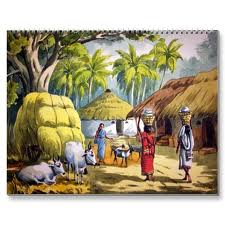












0 Response to "Introduction to Indian Paintings"
Post a Comment